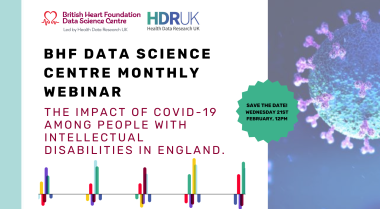Depressive Symptoms and Cardiovascular Disease
1 March 2021
Recent research leveraging cohort data from the Emerging Risk Factors Collaboration and the UK Biobank provides the clearest evidence to date that depressive symptoms, including those below clinical levels, increase the risk of cardiovascular disease.

Depression is a common mental disorder affecting more than 264 million people worldwide – whilst cardiovascular disease a general term for conditions affecting the heart or blood vessels including heart disease, heart attack, and stroke. To date, many studies have provided evidence for an association between depressive symptoms and cardiovascular disease. But, as noted by Harshfield and colleagues in their recent paper, this evidence is often hampered by limited statistical power, the use of broad psychological measures of distress, and inconsistent definitions of disease.
Well-powered data
To help address the uncertainties underpinning the current evidence base, the Cambridge-led consortium used readily available data from more than 560,000 participants in 22 cohorts from 8 countries to investigate whether depressive symptoms are associated with a subsequent risk of CVD. This included individual participant-level data from people taking part in multiple cohorts: (1) the Emerging Risk Factor Collaboration (ERFC) between 1960-2008 and (2) the UK Biobank between 2006-2010. In both cases, the baseline was self-reported symptoms of depression and no history of CVD; and all participants were assessed for incident fatal or nonfatal coronary heart disease (CHD), stroke, and CVD, in March 2020.
A new piece of the puzzle
Pooled analyses of the data revealed that depression, at any level, increases your risk of CVD (though it is important to note that the perceived higher risk was small) — and this association is independent of conventional risk factors. After controlling for important confounders including age, sex, smoking status and history of diabetes, people with depressive symptoms (even where mild) had a higher risk of CVD including stroke. Confirming previous observations, these findings speak to the need for a holistic approach to mental and physical health and the potential for more vigilant monitoring for CVD in people with depressive symptoms.
As flagged in the paper, however, these results are not necessarily representative of the wider population. Data drawn from both the UK Biobank and ERFC was largely from people of European ancestry, meaning the gap of well-powered studies remains for ethnic minority groups.
Abstract:
Importance It is uncertain whether depressive symptoms are independently associated with subsequent risk of cardiovascular diseases (CVDs).
Objective To characterize the association between depressive symptoms and CVD incidence across the spectrum of lower mood.
Design, Setting, and Participants A pooled analysis of individual-participant data from the Emerging Risk Factors Collaboration (ERFC; 162 036 participants; 21 cohorts; baseline surveys, 1960-2008; latest follow-up, March 2020) and the UK Biobank (401 219 participants; baseline surveys, 2006-2010; latest follow-up, March 2020). Eligible participants had information about self-reported depressive symptoms and no CVD history at baseline.
Exposures Depressive symptoms were recorded using validated instruments. ERFC scores were harmonized across studies to a scale representative of the Center for Epidemiological Studies Depression (CES-D) scale (range, 0-60; ≥16 indicates possible depressive disorder). The UK Biobank recorded the 2-item Patient Health Questionnaire 2 (PHQ-2; range, 0-6; ≥3 indicates possible depressive disorder).
Main Outcomes and Measures Primary outcomes were incident fatal or nonfatal coronary heart disease (CHD), stroke, and CVD (composite of the 2). Hazard ratios (HRs) per 1-SD higher log CES-D or PHQ-2 adjusted for age, sex, smoking, and diabetes were reported.
Results Among 162 036 participants from the ERFC (73%, women; mean age at baseline, 63 years [SD, 9 years]), 5078 CHD and 3932 stroke events were recorded (median follow-up, 9.5 years). Associations with CHD, stroke, and CVD were log linear. The HR per 1-SD higher depression score for CHD was 1.07 (95% CI, 1.03-1.11); stroke, 1.05 (95% CI, 1.01-1.10); and CVD, 1.06 (95% CI, 1.04-1.08). The corresponding incidence rates per 10 000 person-years of follow-up in the highest vs the lowest quintile of CES-D score (geometric mean CES-D score, 19 vs 1) were 36.3 vs 29.0 for CHD events, 28.0 vs 24.7 for stroke events, and 62.8 vs 53.5 for CVD events. Among 401 219 participants from the UK Biobank (55% were women, mean age at baseline, 56 years [SD, 8 years]), 4607 CHD and 3253 stroke events were recorded (median follow-up, 8.1 years). The HR per 1-SD higher depression score for CHD was 1.11 (95% CI, 1.08-1.14); stroke, 1.10 (95% CI, 1.06-1.14); and CVD, 1.10 (95% CI, 1.08-1.13). The corresponding incidence rates per 10 000 person-years of follow-up among individuals with PHQ-2 scores of 4 or higher vs 0 were 20.9 vs 14.2 for CHD events, 15.3 vs 10.2 for stroke events, and 36.2 vs 24.5 for CVD events. The magnitude and statistical significance of the HRs were not materially changed after adjustment for additional risk factors.
Conclusions and Relevance In a pooled analysis of 563 255 participants in 22 cohorts, baseline depressive symptoms were associated with CVD incidence, including at symptom levels lower than the threshold indicative of a depressive disorder. However, the magnitude of associations was modest.



